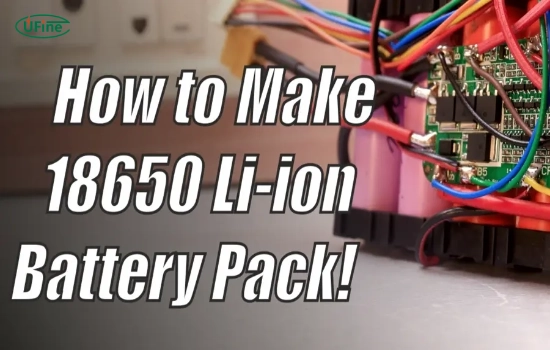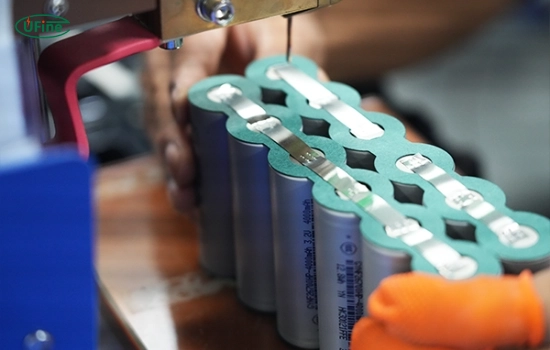Creating a DIY 18650 battery pack is an engaging and practical endeavor for electronics enthusiasts. This guide will detail the step-by-step process of designing, assembling, and validating a functional 18650 battery pack. This article will offer comprehensive insights into each crucial build stage, from selecting the cells to wiring the components.
Part 1. 18650 Battery pack design
Determine the Load Current: Assess the device’s power needs to find its operating current. Measure the current drawn during regular use and peak demand. This helps establish the necessary load current.
Calculate the Capacity: Estimate the energy required for the device over a specific time. Consider power consumption, usage duration, and operational cycles to determine the needed capacity.
Select the Cells: Choose 18650 cells from trusted brands based on capacity, discharge rate, and reliability. Ensure compatibility with load current and calculated capacity.
Determine the Number of Cells: Balance capacity and voltage requirements to find the correct number of cells. Consider series and parallel connections to meet voltage and capacity needs without sacrificing size or weight constraints.
Part 2. DIY 18650 battery pack components and tools
Creating a DIY 18650 battery pack requires specific components and tools for a successful assembly. Here’s a detailed list:
1. Components
- 18650 Cells: Select cells from renowned brands based on capacity, discharge rate, and reliability.
- Battery Holder: Choose an appropriate holder to house the cells securely and ease the wiring process.
- Battery Management System (BMS): Essential for cell protection, ensuring balanced charging, and preventing overcharging or over-discharging.
- Casing or Shell: Select a suitable casing offering durability, heat dissipation, and protection for the assembled pack.
- Wiring Materials: Gather appropriate wires, connectors, and insulating materials for safe and reliable connections.
- Spot Welder or Soldering Equipment: Necessary for connecting cells securely and reliably without causing damage.
- Testing Equipment: Include multimeters or voltage testers to verify the pack’s capacity and voltage after assembly.
2. Tools
- Spot Welder or Soldering Iron: For connecting cells without compromising their integrity.
- Wire Cutters and Strippers: Essential for preparing wires and ensuring clean connections.
- Heat Gun or Shrink Wrap: Helps in insulating connections and providing added protection.
- Battery Charger: Required for charging the assembled pack to its operational capacity.
- Safety Gear: Safety glasses, gloves, and a well-ventilated workspace to ensure safe handling of components.
- Manuals and Guides: Reference materials for tools or components to aid assembly.
- Workspace Setup: Organize a dedicated space with ample lighting for assembly, ensuring a clean and orderly work environment. Gathering these components and tools beforehand ensures a smooth and efficient assembly process for your DIY 18650 battery pack.
Part 3. Selecting 18650 cells
Choosing the 18650 cells for a DIY battery pack involves several critical considerations to ensure optimal performance, safety, and compatibility. Here’s a comprehensive breakdown with specific attention points:
1. Capacity Consideration
Assess the power needs of your project. For instance, if you’re building a high-drain flashlight requiring extended usage, opt for cells with higher capacities, such as those rated around 3000mAh or more; however, if compactness is a priority, balance capacity, and size accordingly.
2. Discharge Rate Matching
Align the cell’s discharge rate with the device’s requirements. Devices with high power demands, like power tools, demand cells with higher discharge rates (e.g., 20A or higher) to handle the load without compromising performance.
3. Reliable Brands and Sources
Prioritize renowned brands known for quality and authenticity. Panasonic, Samsung, LG, and Ufine are reputable manufacturers known for producing reliable 18650 cells. Purchasing from authorized distributors or trusted suppliers ensures authenticity and reliability.
4. Compatibility with BMS
Ensure the selected cells are compatible with your intended Battery Management System (BMS). For instance, if your BMS has specific voltage or current limitations, choose cells that comply with these parameters to avoid compatibility issues.
5. Application-Specific Cells
Consider specialized cells tailored for specific applications. For example, some cells are optimized for high-drain applications like vaping or electric vehicles. In contrast, others focus on energy density for consumer electronics.
6. Datasheet Scrutiny
Study datasheets thoroughly. Look for detailed specifications regarding capacity, discharge rates, nominal voltage, and operating temperature range. Match these specs to your project’s requirements for a precise fit.
7. Cell Age and Storage Conditions
Prefer newer cells with recent manufacturing dates and proper storage conditions. Older cells or those stored improperly might suffer from reduced capacity or performance issues.
8. Safety Features and Certifications
Prioritize cells with built-in safety features like protection against overcharging, over-discharging, and short-circuiting. Look for cells compliant with relevant safety certifications, enhancing the overall safety of your battery pack.
Part 4. Assembled 18650 battery pack
Each step in assembling the 18650 battery pack, from selecting the holder to wiring the components, is crucial in ensuring the pack’s functionality, safety, and longevity. Meticulously evaluate these factors and possibly.
18650 Battery Holder
Selecting the right battery holder is crucial for secure housing and organizing the 18650 cells. Choose a holder that matches the number of cells in your pack’s configuration (series or parallel) and ensures snug fitting without excessive pressure on the cells. A well-suited holder simplifies wiring and safeguards against accidental shorts.
Operational Detail :
When assembling the battery pack, carefully place the 18650 cells into the designated slots of the holder, ensuring proper orientation (positive and negative terminals). Verify that each cell is seated securely without wobbling or misalignment before wiring connections.
18650 Battery Spot Welder
A spot welder or appropriate welding equipment ensures secure and reliable connections between the battery cells. Proper welding techniques prevent excessive heat generation and cell damage while establishing solid electrical connections for the pack’s performance and safety.
Operational Detail :
When spot welding, precisely align the welding pen’s tip on the nickel strip over the cell terminal. Apply consistent pressure and activate the welder for the specified duration, typically milliseconds. This allows the current to create a potent fusion between the strip and terminal.
Adding the BMS
Integrating a Battery Management System (BMS) is critical for the safety and longevity of the battery pack. The BMS protects cells from overcharging and over-discharging and ensures balanced charging across all cells. Connect the BMS in line with the cells and verify the compatibility with the cells and overall pack configuration.
Operational Detail :
When connecting the BMS to the cells, carefully solder the wires from the BMS to each cell terminal. Ensure the cables are of appropriate gauge to handle the expected current and are adequately insulated to prevent short circuits.
Select the Shell or Casing
Selecting a suitable shell or casing for the assembled battery pack is essential for protection, heat dissipation, and overall durability. Choose a casing that accommodates the configured cells while allowing sufficient ventilation to prevent overheating. The casing should also provide adequate protection against physical damage and environmental factors.
Operational Detail :
When selecting a plastic casing, verify the thickness and quality of the material. Consider designs with snap-fit features for easy assembly and disassembly while maintaining structural strength. When choosing an aluminum casing for high-power applications, consider designs with heat sinks or fins that effectively dissipate heat. Mounting the cells securely inside the casing with thermal pads can enhance heat transfer and protect against overheating.
Wiring the Components
Wiring the components involves careful planning and execution to establish connections between the cells, BMS, and other necessary elements. Use high-quality wires, ensuring appropriate gauges can handle the pack’s current requirements. Organize the wiring layout methodically, minimizing clutter and ensuring clear identification of positive and negative terminals.
Operational Detail :
When wiring the BMS, carefully solder the designated wires from the BMS to their corresponding cell terminals. Double-check polarity and insulation to avoid shorts, following the BMS wiring diagram precisely. While wiring the components, ensure all soldering joints are clean and free from excess flux residue, as it can attract moisture and lead to corrosion, potentially compromising the connections’ integrity over time.
Part 5. Check the 18650 battery pack capacity and voltage
After assembling a DIY 18650 battery pack, verifying its capacity and voltage is crucial to ensure its functionality aligns with the intended application.
Capacity Verification
Utilize a battery capacity tester or analyzer to measure the actual capacity of the assembled battery pack. Connect the tester to the pack and follow the manufacturer’s instructions to initiate the testing process.
Testing Procedure
Please charge the battery pack to its total capacity before testing. Discharge it through the capacity tester while recording the energy output. Compare the registered capacity with the expected or calculated capacity to assess discrepancies.
Voltage Assessment
Use a multimeter or voltage meter to measure the overall voltage output of the assembled battery pack. Connect the meter’s probes to the positive and negative terminals of the pack and record the voltage reading.
Voltage Balance Check
If the battery pack comprises multiple cells connected in series or parallel, measure the voltage across individual cells. Ensure uniformity in voltage levels among cells to confirm balanced charging and discharging.
Evaluation and Analysis
Analyze the recorded capacity and voltage readings against the anticipated values. Evaluate deviations or variations and assess if they fall within an acceptable range based on the pack’s intended usage.
Troubleshooting Discrepancies
Inspect the connections, individual cell voltages, and BMS functionality in case of significantly lower capacities or irregular voltage readings: re-check wiring, balance, and possible damage to cells or components.
Documentation and Maintenance
Record the measured capacity, voltage readings, and any deviations observed for future reference or maintenance. Implement corrective measures if needed and recalibrate the pack accordingly.
Operational Detail :
When using a battery capacity tester, input the specified settings, such as the discharge rate and duration, according to the pack’s specifications. Observe the tester’s readings and compare them against the expected capacity. When measuring individual cell voltages, ensure the multimeter’s probes properly contact each cell’s terminals. Compare the readings to identify any cells with significantly lower or higher voltages, which may indicate imbalances or potential issues.
Part 6. FAQs
-
What is the lifespan of an 18650 battery?
The lifespan of an 18650 battery typically ranges from 2 to 5 years or around 300 to 500 charge cycles, contingent upon usage patterns, charging practices, and environmental factors. -
Is there a substitute for an 18650 battery?
Depending on the device’s specifications, batteries like 21700, 20700, or other lithium-ion cells with similar voltage and size characteristics could substitute for 18650 batteries. -
How can you tell a fake 18650 battery?
Identifying fake 18650 batteries involves examining labels, packaging, and performance. Discrepancies in labels, missing safety features, or significantly lower capacity than advertised indicate counterfeit batteries. -
Will an AA battery work for an 18650?
AA batteries are generally unsuitable substitutes for 18650 batteries due to size, voltage, and capacity differences. AA batteries are smaller and have lower voltage and capacity than 18650 batteries.
Related Tags:
More Articles

How to Choose the Best Floor Scrubber Battery for Commercial Cleaning?
Selecting the ideal floor scrubber battery ensures a long runtime, rapid charging, and minimal maintenance for efficient commercial cleaning operations.
Battery for Blower vs Battery for Leaf Vacuum: Which One Should You Choose?
Battery for blower vs leaf vacuum—learn the key differences in power, fit, and runtime to choose the right battery for your outdoor tool needs.
How to Choose the Right Battery for Blower?
Choosing the right blower battery? Consider voltage, capacity, chemistry & usage. This guide helps match the best battery for peak performance.
How to Choose the Best Insulated Battery Box for Lithium Batteries?
Choosing the Best Insulated Battery Box for Lithium Batteries? Discover key factors such as size, material, and safety for optimal protection and performance.
7 Critical Elements on a Lithium Battery Shipping Label
What must be on a lithium battery shipping label? Learn 7 key elements to ensure safety, legal compliance, and correct handling across all transport modes.





